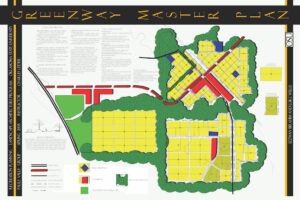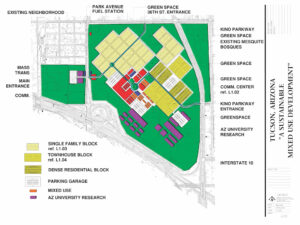Urban Planning
Mixed Use Urban Design
The mixing of different land uses in urban development is nothing new. Residential, Retail, Entertainment, Lodging, Civic, Cultural, and Commercial uses have been centralized in one relatively discrete area since the ancient towns and cities of Greece and China, to the compact and tightly walled cities of medieval Europe. Due to the rise of the automobile as a dominant mode of transportation, growing affluent communities and implementation of land use regulations, this pattern of closely mixed uses in urban areas has been undermined. However, mixed use development is emerging and is offering new approaches to modern development. The Urban Land Institute states that Mixed Use Developments can be identified by three different characteristics:
- Three or more significant revenue-producing uses such as retail/entertainment, office, residential, hotel, and/or civic/cultural/recreation; that in well-planned projects are mutually supporting.
- Significant physical and functional integration of project components (and thus a relatively close-knit and intensive use of land), including uninterrupted pedestrian connections.
- Development in conformance with a coherent plan that frequently stipulates the type and scale of uses, permitted densities, and related items.

A sense of place, streetscapes, public spaces, pedestrian circulation, amenities and parking are a few issues or elements that are crucial to the economic success of a mixed-use project. Ultimately, a mixed use project design is an exercise in place making, not just real estate development, and requires a vision for the place to be created. The vision can come from many sources such as community members, key tenants, urban designers, developers, public sector leaders and hotel operators, but in the end it is a shared vision. Oklahoma Landscape Architects can help with that vision, and can work through the whole design process from concept to implementation.
When developing a site, whether it is Mixed Use, Commercial, Residential or Public, then experience in Site Engineering is key to the developments success. Oklahoma Landscape Architects has extensive experience designing Site Grading, Stormwater Management, Vehicular Circulation, Pedestrian Circulation, Bicycle Circulation, Retaining Walls, Paving, Decks, and Lighting. The health, safety and welfare of the public is the primary goal of Oklahoma Landscape Architects during the entire design phase. The surrounding land use and existing grading is analyzed during the first site visit to get a sense of the impact of the proposed development. Grading and Drainage is a primary determinant in the total design, and Oklahoma Landscape Architects will ensure that grading becomes an integral part of the design process. Most erosion on a construction site, or existing project, is caused by flowing water. This erosion can be extremely destructive, but is usually preventable with proper planning. The key determinants controlling the volume and velocity of runoff are the size and shape of the watershed, the porosity of the soil and the gradient and length of its slopes and channels. Oklahoma Landscape Architects know many techniques that can reduce the volume and velocity of runoff, giving you peace of mind during the storm.
It is important that when choosing a Landscape Architect for your project that they understand the issues that must be addressed when developing stormwater management techniques. Oklahoma Landscape Architects knows that Flood Protection, whether it is a two year storm, or a one hundred year storm, can put lives and significant structures at risk. With experience in Storm Water Protection Plans, we can also protect the Water Quality of an adjacent site to make sure that Sedimentation, Heavy Metals, Chemical Contaminants and Pathogens do not pollute an adjacent waterway during construction or in the future. With Oklahoma Landscape Architects, you will have an experienced team in the design and construction of Rain Gardens and Groundwater Recharge Systems. The replenishment of groundwater is important to maintain the elevation of the existing water table, and the more impervious material installed, such as concrete or asphalt without proper planning, then this elevation will be sure to decrease. Wildlife Habitat depends on levels and quality of water. Urbanization, without proper design, can change the availability and quality of the water to sustain existing wildlife. When major changes occur to water quality then existing plant material dies and is replaced with another plant that may or may not be used by existing wildlife. This is when Quality of Life for the client and surrounding land uses can be affected. You can be sure that Oklahoma Landscape Architects will do everything within our ability to improve this Quality of Life for yourself, family, friends, coworkers & neighbors when designing and implementing these site engineering and stormwater management techniques.

The design of circulation within your site is essential to its success. When designing for Pedestrian Circulation we analyze the differences in purpose of the various types of systems that will be utilized, and make them part of the aesthetic experience. Successful circulation is when amenities, uses and destinations are connected conveniently and can meet the requirements of orientation and negotiation. With experience in successful Bicycle Circulation within a site or city, Oklahoma Landscape Architects understands the cyclists objectives and needs. Bicyclists fall into two major categories: Recreational Bicyclist & Functional Bicyclist, and both will utilize Paths, Bicycle Lanes or a Shared Roadway. The Safe and Aesthetic Layout of a Bike Trail, Path or Lane is taken into account during the design phase to ensure a successful project. Vehicular Circulation is another type of system of circulation that is necessary in any Mixed Use Urban project. The layout of streets, roads or alleys will determine the scale, form and environmental impact of the future development. A well designed road will fit into the surrounding landscape while maintaining the driver’s sight lines, views, and three dimensional aspects along with the aesthetic experience of the roadway and existing layout of the contouring landform.
The finishing touches to your project usually includes: Site Furnishings, Plant Material, and Lighting. These are the minor details that make the experience so unique and special. Color, Space, Form and Texture and anything that stimulates the senses, are what will make your visitors remember the sense of place that you have worked so hard to develop. We at Oklahoma Landscape Architects specialize in these details with successful plant pallets, proven design techniques and an understanding of how to successfully implement your best project.
